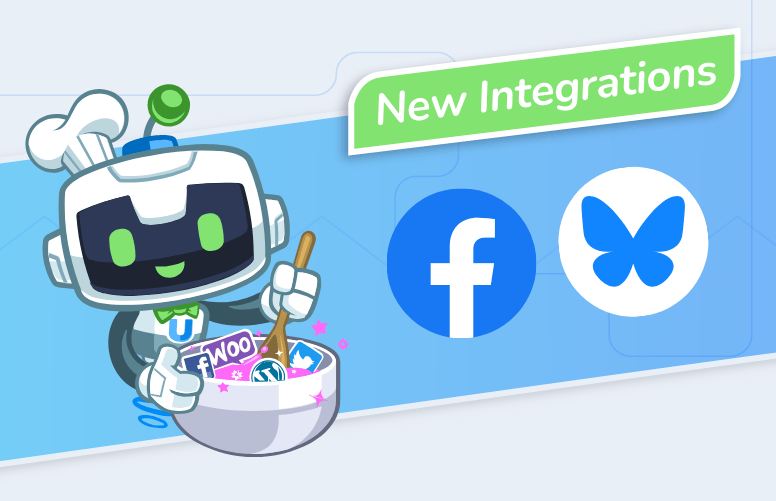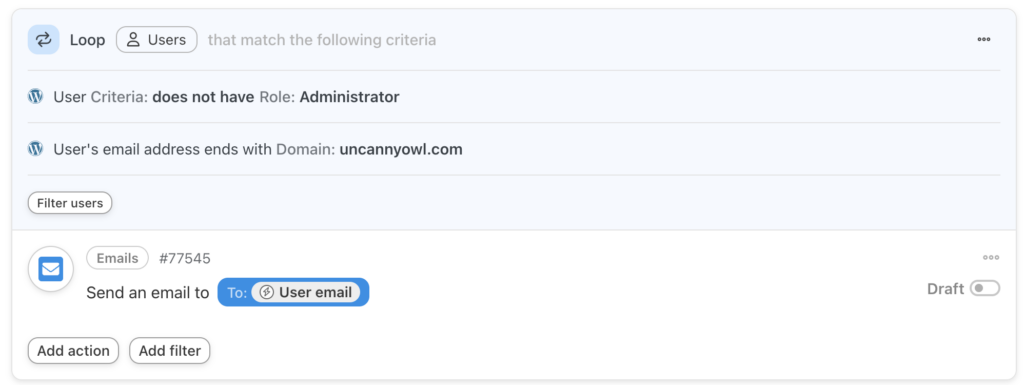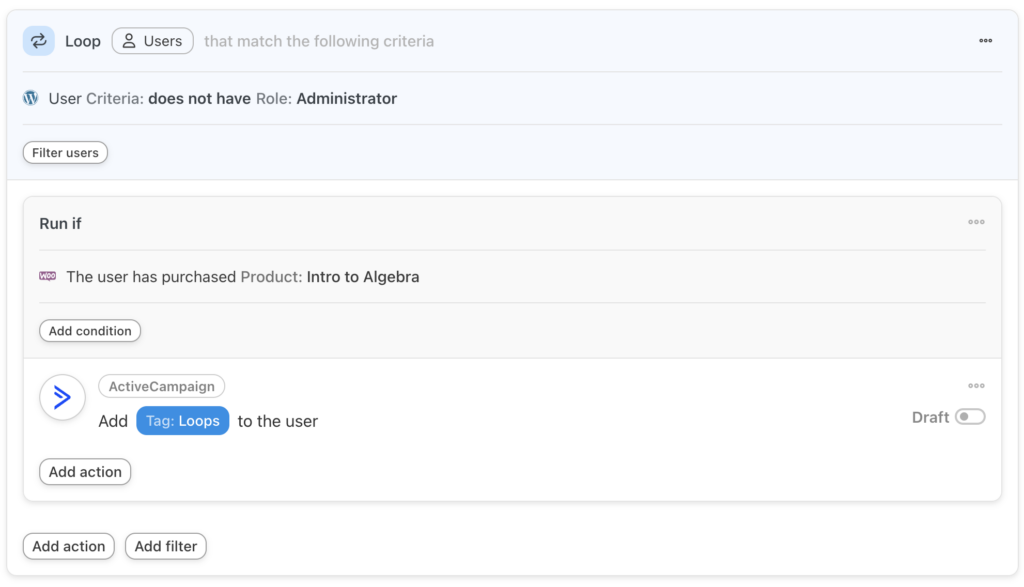Automator 6.4 : Publicités Facebook, Bluesky et puissantes améliorations de l'apprentissage en ligne
Uncanny Automator 6.4 introduit les publicités Facebook Lead, Bluesky et des tonnes de nouveaux déclencheurs puissants et…
Exactly what is “Uncanny Automator”? It’s a question that WordPress users often ask and that we give a lot of thought to ourselves. Is it just an integration tool, connecting WordPress plugins, sites, and non-WordPress apps together? Is it a workflow automation tool? Is it a no-code application builder?
We at Uncanny Owl generally think of it as an automation tool, so as we build improvements and add new features, we’re always thinking about how we can save our users time and cost with automation.
In today’s Uncanny Automator Pro 5.0 release, we’re introducing a new tool that’s a lot more about automation than integration. This new feature, which we’re calling Loops, will completely change how you use Automator—and how you think about what’s possible on your WordPress site.
Right now, Automator recipes run when something happens, and then they perform actions that typically affect one thing–often a user or a post. Maybe when a user buys a product, they’re added to a membership. This affects one single user for each recipe run. But what if the recipe could perform actions on multiple “things” at once, in bulk? That’s where the magic of “loops” comes it, as it allows you to loop through many things and run actions on each of them.
Without further ado, here’s a screenshot of a loop inside a recipe:
The example above basically says, “Okay, when the triggers for the recipe are complete, loop through all users that aren’t administrators and have an @uncannyowl.com email address, and for each user matching that criteria, send them an email.” So, yes, all of these types of scenarios are now possible with Automator Pro:
It’s as amazing as it sounds and will open up a world of possibilities for WordPress automation. And yes, it fully supports conditions, so you can set up a looping action like this:
In that example, any non-admin users that have purchased a specific product would have a CRM tag applied when a recipe run is initiated. And yes, if you’re wondering if you can have multiple loops in a recipe, or multiple actions in a loop, you can! Loops are an incredibly flexible tool that were designed to be included seamlessly into your recipes, not something that’s independent and can only be run on demand.
We know that the introduction of bulk operations like this can be heavy on hosting environments, so we built loops from the ground up to ensure they won’t affect front end performance. Loops run in batches in the background, with a small delay between batches, and inside the logs for a recipe run you can see loop progress, pause it, and even cancel loop runs.
The initial release of Loops, while exciting, is something of a teaser for what’s to come. Once customers start using it, we know they’ll be hungry for new features. Rest assured that we are already hard at work on them, and you can safely assume that over the next few months we will be adding the logical additions that aren’t in the 5.0 release, including:
There’s a lot more planned, and the next few months will likely be the most exciting in Automator’s history.
While Loops are an incredible tool, there is a lot to consider before you jump in with complex loop actions. Here are a few things that should be considered:
Uncanny Automator Pro 5.0 is a huge release that was months in the making, so it also includes many other new features.
Charitable gets these new triggers and actions:
Want to follow up when a donor terminates their payments or reward loyal donors for donation milestones? Now it’s easy.
MemberPress gains a new trigger for a sub-account being removed from a parent account.
In our AffiliateWP integration, there’s now an action to link a customer to an affiliate for lifetime commissions.
Our Formatter tool adds an action to extract the first word from a string. This is especially useful for plugins and tools that capture a full name in a single field and you need to extract and use someone’s first name only.
Over in LearnDash, there’s a new action to Reset the user’s progress for all courses associated with a group. Now this one is a powerful one for the new Loops tool, as it allows use cases like having a Group Leader be able to submit a form that loops through everyone in a group and resets course progress for all courses associated with that group.
In WordPress Core, there’s one new action: Fetch an existing user. This action lets you use tokens containing the information of an existing user in a subsequent action, or simply check if a user exists.
In terms of other highlights, there’s also a new WordPress condition for a user’s email address matching a specific domain. Other improvements are outlined in the full changelog.
We hope you find the release useful, especially Loops. Getting this piece out was a huge accomplishment for our team and will pave the way for an incredibly rich future of Automator releases.

Uncanny Automator 6.4 introduit les publicités Facebook Lead, Bluesky et des tonnes de nouveaux déclencheurs puissants et…
Nous utilisons des cookies pour améliorer votre expérience sur notre site. En utilisant notre site, vous acceptez l'utilisation des cookies.
Gérez vos préférences en matière de cookies ci-dessous :
Les cookies essentiels permettent des fonctions de base et sont nécessaires au bon fonctionnement du site Web.
Les cookies statistiques collectent des informations de manière anonyme. Ces informations nous aident à comprendre comment les visiteurs utilisent notre site web.
Les cookies marketing sont utilisés pour suivre les visiteurs sur les sites web. L'objectif est de diffuser des publicités pertinentes et attrayantes pour chaque utilisateur.


It’s incredible. I hadn’t used the Automator before, precisely because there were no loops. However, I’m still not sure if I can customize the recipe I need. What I’d like to do: I’d like to customize the Gravity Form of Lerndash’s course assignment. So that I can select a list of courses and a list of users in the form, and the courses have been assigned to them. To customize the forms I use Gravity Perks Populate Anything: https://gravitywiz.com/documentation/gravity-forms-populate-anything. However, dynamic course and user IDs from a form cannot be used as user filter tokens. Is it possible to consider such a recipe scenario, maybe add support for Gravity Perks?
Thanks for the feedback!
I’m afraid it’s not possible for us to modify what options are output in a form, and I’m not sure if it’s something we could support in future either–though certainly we recognize how useful that would be. It doesn’t fit with the Automator recipe model as much though, but certainly we could consider a Gravity Perks integration in future, and potentially that route would allow what you need.